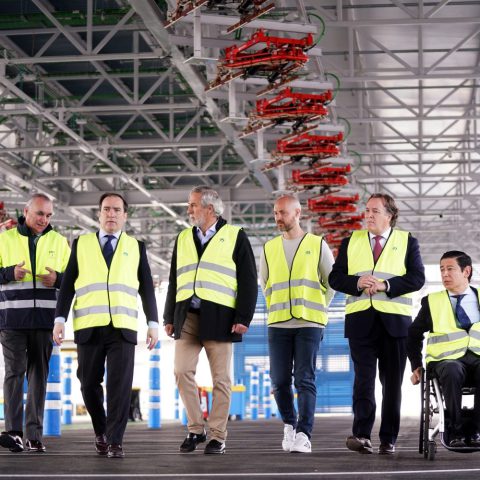118 inverted pantograph chargers added at EMT Madrid Carabanchel depot. 320 charges expected by early 2025
A new inverted pantograph electric charging station has been inaugurated at the Carabanchel operations centre of EMT Madrid. Now the depot has been enhanced with further 118 electric bus’ chargers, enabling a total of 260 vehicles to be charged simultaneously. With the fourth phase of charging station’s conversion still to be completed, the Carabanchel operations […]

A new inverted pantograph electric charging station has been inaugurated at the Carabanchel operations centre of EMT Madrid. Now the depot has been enhanced with further 118 electric bus’ chargers, enabling a total of 260 vehicles to be charged simultaneously.
With the fourth phase of charging station’s conversion still to be completed, the Carabanchel operations centre is expected to have a total of 320 charging points in operation within the end of this year and the beginning of next year: 230 through inverted pantograph system and 90 by plug-in.
EMT Madrid: 118 inverted pantograph chargers added
The Carabanchel operations centre has been undergoing a process of complete transformation as set out in the municipal company’s Strategic Plan. Divided into four phases, the operations centre aspires, with this process, to position itself as a benchmark for electrified infrastructures.
The cost of the work amounts to 6.7 million euros and the total investment budget – which also includes chargers and pantographs – is 11.3 million euros. This amount has been 90% financed by the European Next Generation EU funds.
Today EMT Madrid has 276 electric buses in operation, making up some 13% of the 2,100-units bus fleet. The remaining 1,824 units of this fleet are buses powered by Compressed Natural Gas (CNG) (86.86 %). The PTO expects to have 25% of its fleet electrified by 2025.
EMT Madrid Carabanchel operations centre, works underway
Developed over a surface area of approximately 221×25 metres, the infrastructure established at Carabanchel operations centre is divided into many levels. At ground level a canopy covers the installation and from which hang the pantographs.
Two underground substations have been installed in the area of the canopy to serve the new chargers for a total installed power of 10 MVA.
The charging station also has an innovative fire protection system, gas detection systems, fire extinguishers and thermographic cameras, EMT Madrid stresses.
A total of 40 chargers with 360 kW of electrical power have been installed, which can supply a maximum power of 360 kW to a single pantograph – allowing a complete recharge of a bus in just 1 hour – or 120 kW to three pantographs simultaneously – with 3 hours of charging for each bus.
In the side areas there are two large roofs measuring approximately 221×10 metres and, in the upper part of the technical corridor, there is a photovoltaic roof equipped with 1,055 panels that minimise the energy demand of the infrastructure: this photovoltaic installation covers 10 % of the energy required. The estimated energy output of this installation is 924.6 MWh/year.
Carabanchel operations center, focus on charging e-buses
The first phase of the conversion of Carabanchel operations centre has been carried out between 2018 and 2022. It laid the foundations of the electrification project by incorporating an initial electric charging solution. Subsequently, in February 2023, the second phase was launched, consisting of the commissioning of the first electric charging station by inverted pantograph, which has 52 100 kW charging points.
The third phase is the aforementioned charging station, which doubles the figures of the previous one, as it has more than double the number of charging points (118) and also far exceeds the numbers and results associated with its photovoltaic roof and its electrical transformation centres.







